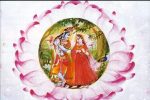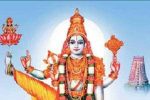NAME 52
Tvaṣṭāḥ त्वष्टाः
At the time of annihilation of the universe, gross matters are absorbed into subtle elements for ultimate absorption into the Brahman. At the time of creation, gross matters originated from subtle elements. TaittirīyaUpaniṣad (II.i.1) says that at the time of creation Self created ether, ether created air, air created fire, fire created water, water created earth, earth created food. At the time of dissolution, the reverse process takes place and at the end of cosmic annihilation, the eternal Brahman alone remains, not even His projecting power known as māyā.
This nāma says that Viṣṇu initiates this annihilation of the universe. All the three aspects of the Brahman have been dealt with, creation, sustenance and annihilation.
Death is different from annihilation. Death is a process by which an individual soul leaves a gross body; whereas annihilation means all the souls pulled out of all the beings to merge with the Brahman. At the end of annihilation, the universe itself disappears. Tvashta the one who created all the different forms and names in this Universe. This name is derived from the root Tvaksh – to pare, to reduce, to chisel.
Bhagavan has “chiseled” so many diverse forms and names of gods, man, birds, plants, insects, etc., and thus He is Tvashta. From the Taittiriya Aranyaka in support –
“Tvashtaram Rupani Vikurvantam Vipascitam ”
Sri Sankara uses the same meaning to interpret this name as indicating that Bhagavan pares down all the beings or makes them shrink at the time of cosmic dissolution or Pralaya. It is interesting to note that the first interpretation refers to the creation of forms and shapes from the primordial matter, and the second interpretation refers to the dissolution of forms and shapes back into primordial matter.
५२. ॐ त्वष्ट्रे नमः
52. Om Tvaṣṭrey Namah
Tvaṣṭā -One who makes gross things of huge dimensions into minutest particles. At the time of the world’s dissolution, the entire gross-world folds back into its subtler elements until at last pure objectless space alone comes to remain. He who makes huge things small. : He who makes all beings shrunken (Tanukarana) at the time of cosmic dissolution. One who created all the different forms and names in this Universe.
INTERPRETATION GUIDED BY SANT VANI (WORDS OF SAINTS)
Tvaṣṭā
The one who dissolves everything.
This word is derived from the verbal root ‘tvaks’ meaning to make thin, to cut down. As the one, who brings about kṣhaya to everything, who dissipates everything at the time of dissolution, the Lord is called Tvaṣṭā. He disintegrates, destroys, dissolves and takes into himself everything.
In creation there is a krama, an order and in dissolution, there is a vyutkrama, that is, the krama is reversed. From a very gross state everything is reduced to a lesser gross state, then into a subtle state and then into an unmanifest state. So the one, who is able to do this is called Tvaṣṭā.
The skilled ‘chiseler’, the divine carpenter, skilled craftsman and divine artificer (skilled inventor/craftsman) who shapes and makes the most wonderful ‘instruments’ and implements (objects and beings that populate the Universe).
OR…
He who reduces gross and large forms into their subtle and minute form. He, who ‘folds-back’ the entire world and in a sense absorbs this web that he has spun, by reducing/paring down all objects and beings into their subtle aspect at the time of Pralayā (the great dissolution).
Śaṅkara prefers the latter interpretation, i.e. the Supreme Being who reduces all objects and beings to their subtle forms and folds-back the Universe into itself. ParāsaraBattar on the other hand prefers to identify the Supreme being as the master craftsman, the supremely skilled artisan who shapes and shines (polishes) the various forms and ‘invests’ each of them with a “definite” form.
With specific reference to this name, Parāsara Battar‘s interpretation of this name fits-in better and makes more practical sense when read along with the previous two names in this string – Viśwákarma and Manuḥ.
As we saw in interpreting the previous two names, at a practical level it is important for us to understand that it is we who create our own reality. The world appears to us as we see it and as we relate to it. The change we want to see in the world can only be possible by changing from the “inside-out” and for that to happen each one of us has to allow the Viśwákarma within us to flower and express himself/herself to his/her fullest creative potential. Similarly, for this flowering to occur it requires deep thinking and reflection on the real nature of the world and the Self within and a strong aid in this reflection is the Mantra and contemplation on The Higher Self, which is the symbolic manifestation of the supreme being.
Now, by connecting the name Tvaṣṭā to these two names, we realize that in order for this change to occur and to flower, it requires each one of us to be like master craftsmen or skilled carpenters who can “chisel” and ‘shape’ our lives with the aid of the indwelling supreme being as our friend, guide, mentor, and supreme Guru.
These three names are as clear an indicator as any that our destinies lie in our own hands and that this is the extent of, and purpose of exercising one’s own free will. It requires an acknowledgement from each one, that the Supreme Being of the entire Universe is also the very same person who animates each one of us from within – he is the architect, the builder, the building, as well as the interior decorator and when we turn our gaze inwards and ask for guidance, he steps forward to take your hand.
https://os.me/its-okay-to-change/
Ramana Mahrishi was known for his brevity and absolute clarity and to quote him here would be apt:
“Look within. Don’t look around.”



